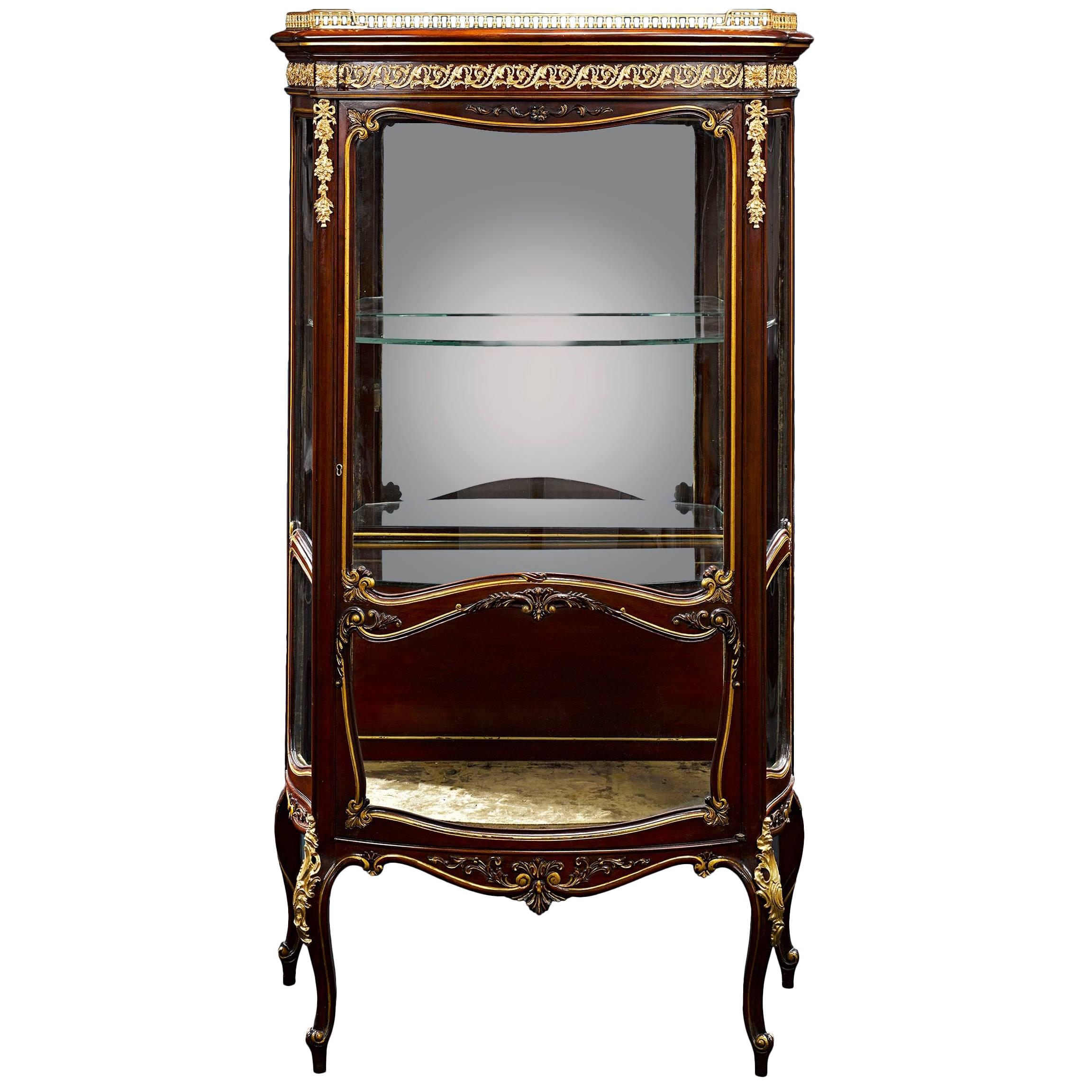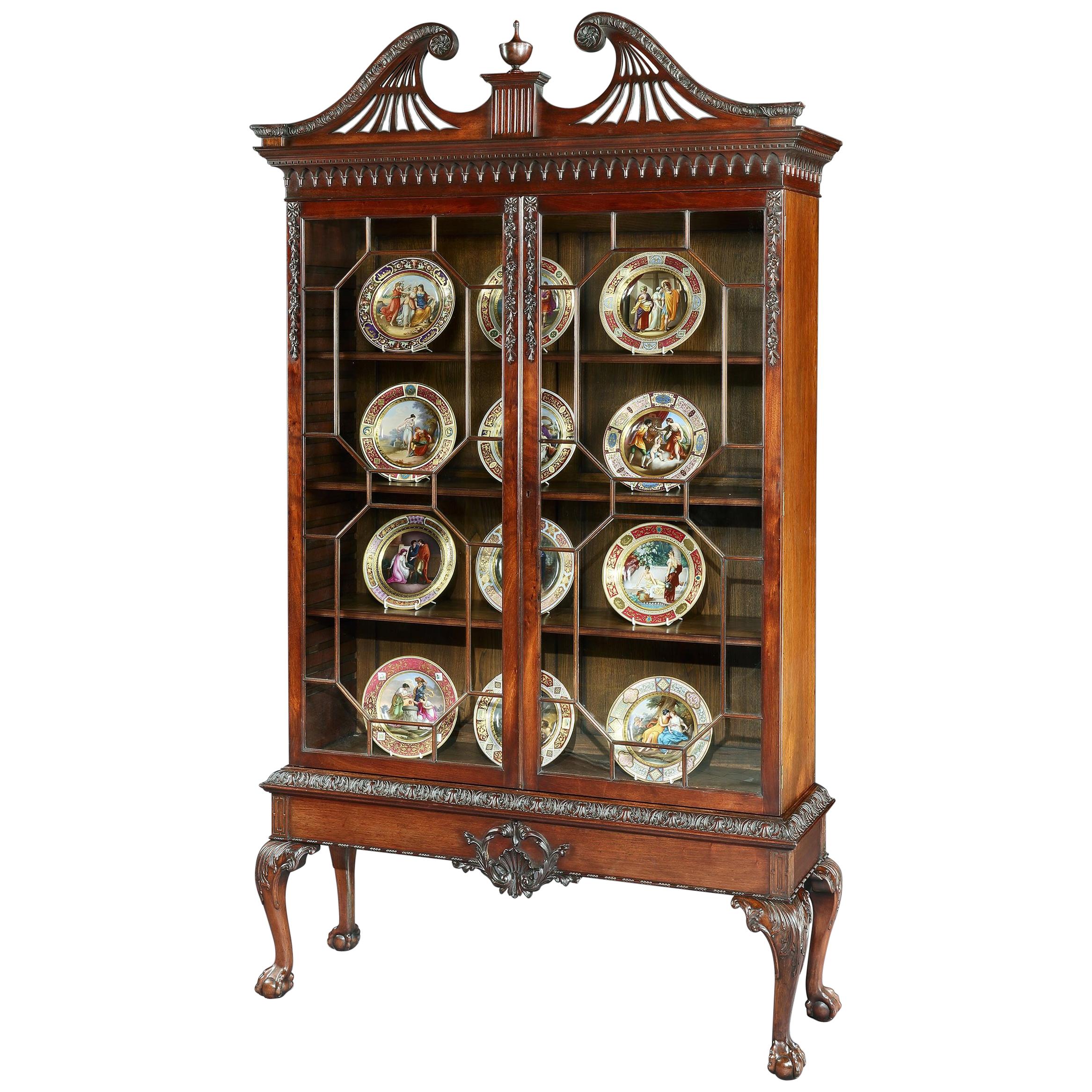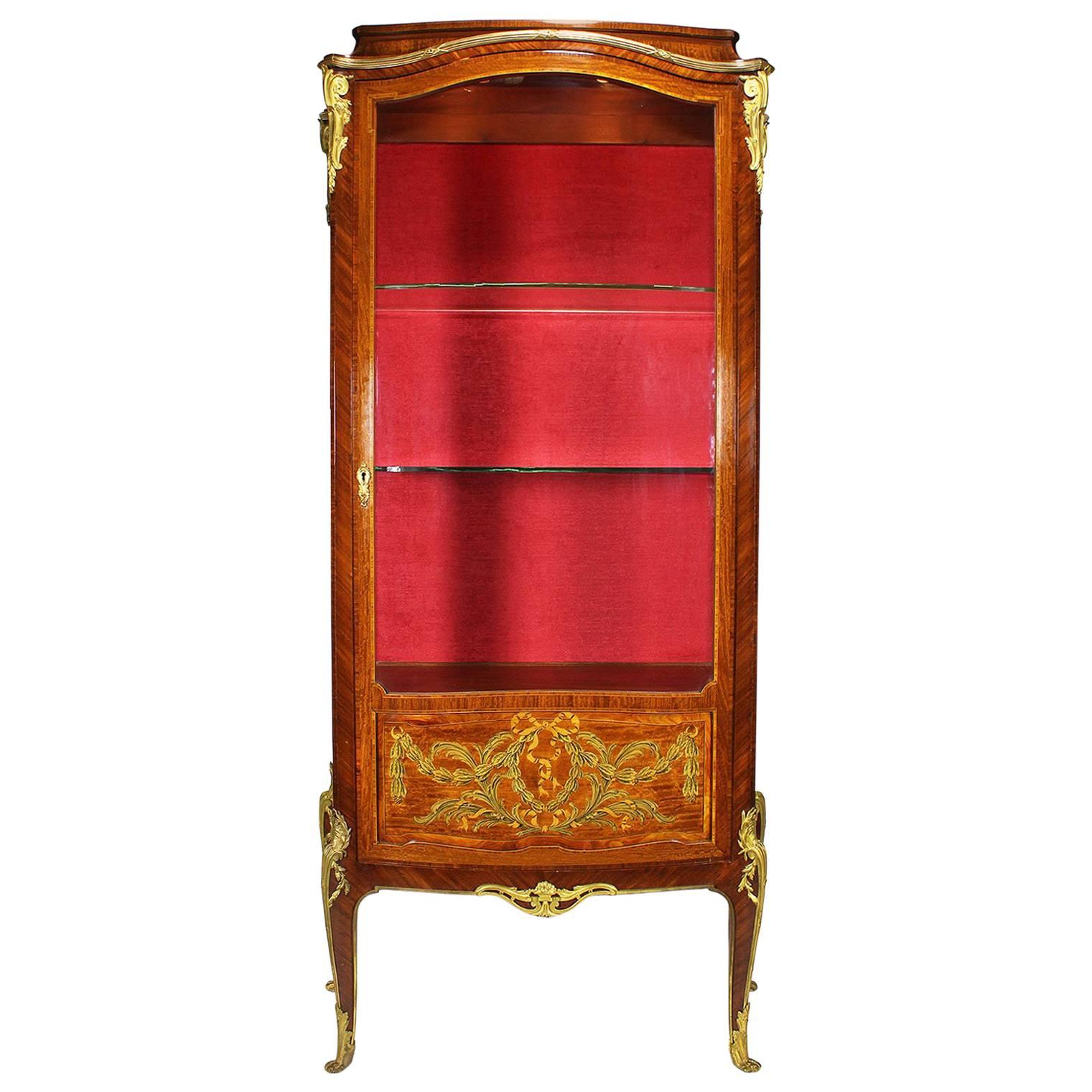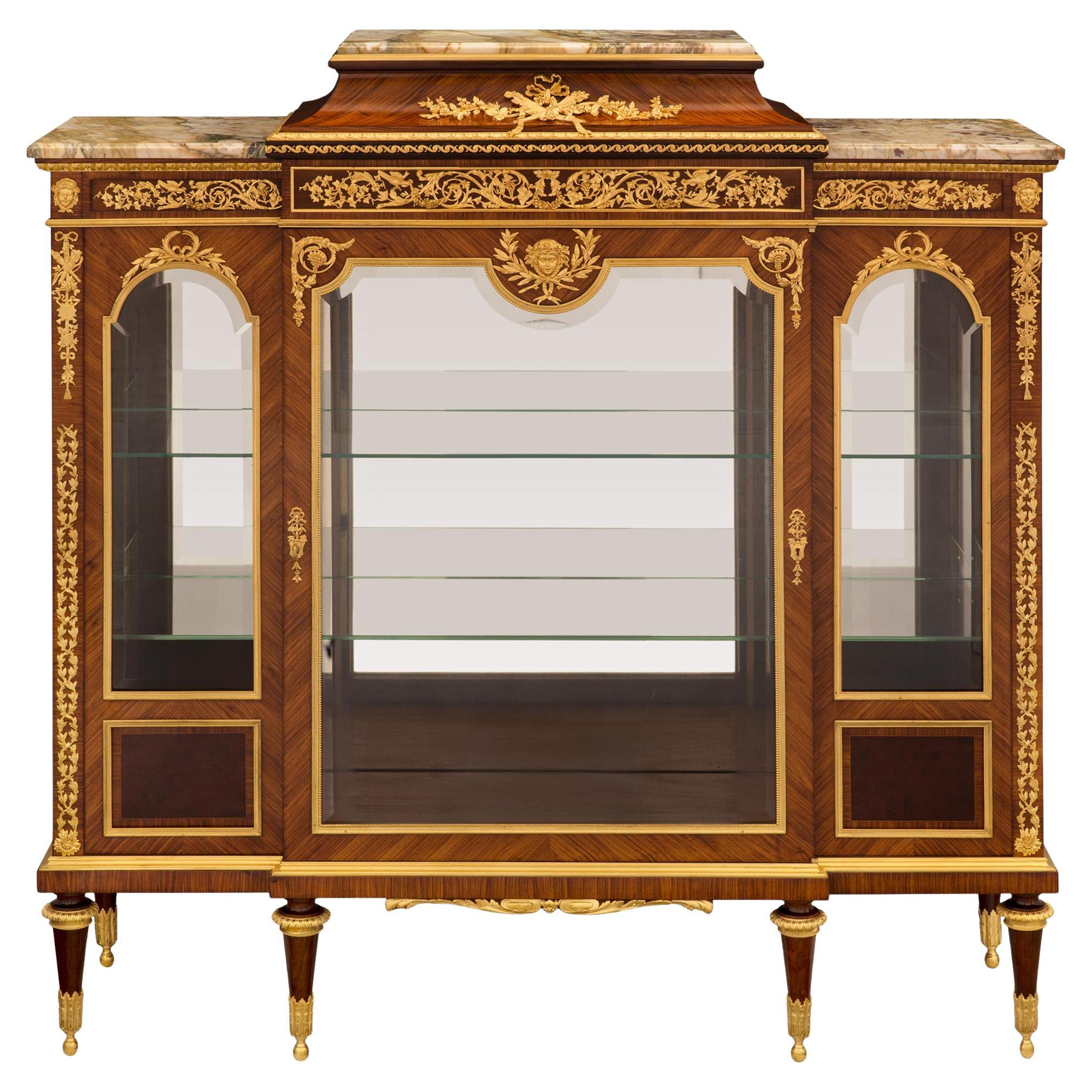Items Similar to 19th Century French Belle Époque Display Cabinet in the Manner of François Linke
Want more images or videos?
Request additional images or videos from the seller
1 of 7
19th Century French Belle Époque Display Cabinet in the Manner of François Linke
About the Item
A French Bijouterie
In the manner of François Linke
Designed in the Louis XV style and constructed in a wonderfully marked Kingwood, with precise and crisply cast ormolu mounts; rising from sabot shod cabriole legs dressed with ormolu espagnolettes, the velvet-lined display case having a shaped apron, each side of curved bombé form and set with expertly shaped glass panels; the lockable door opening to gain access to the glass-shelved interior; the lockable rising top with a shaped and bevelled glass and ormolu guard strip.
French, circa 1900
Only the best Parisian workshops were able to Craft exquisite display cases of this quality, requiring access not only to attractive Kingwood timbers, but also requiring the skills to fit the curved glass to the bombé frame, itself applied with precise ormolu mounts. Identical sabots are observed on a bijouterie by François Linke previously with Butchoff.
- Similar to:François Linke (Cabinetmaker)
- Dimensions:Height: 32.5 in (82.55 cm)Width: 27 in (68.58 cm)Depth: 17 in (43.18 cm)
- Style:Louis XV (In the Style Of)
- Materials and Techniques:
- Place of Origin:
- Period:
- Date of Manufacture:circa 1900
- Condition:Repaired: Each item has undergone careful inspection and restoration by a conservation specialist in order to guarantee the original quality and integrity of the object. Wear consistent with age and use.
- Seller Location:London, GB
- Reference Number:
About the Seller
5.0
Recognized Seller
These prestigious sellers are industry leaders and represent the highest echelon for item quality and design.
Platinum Seller
These expertly vetted sellers are 1stDibs' most experienced sellers and are rated highest by our customers.
Established in 1964
1stDibs seller since 2012
43 sales on 1stDibs
Typical response time: 3 hours
Associations
The British Antique Dealers' AssociationLAPADA - The Association of Arts & Antiques Dealers
- ShippingRetrieving quote...Ships From: London, United Kingdom
- Return PolicyA return for this item may be initiated within 3 days of delivery.
More From This SellerView All
- 19th Century Display Cabinet in the Manner of Thomas ChippendaleBy Thomas ChippendaleLocated in London, GBA display cabinet in the manner of Thomas Chippendale. Constructed in a well-figured Honduras mahogany, with carved highlights; rising from cabriole leg 'ball and claw' feet, with acanthus carving at the knees, with swept and carved corner blocks; over, a running 'egg-and-dart moulding with a central leaf carved cartouche centred about a scallop shell, are two lockable glazed doors, with astragals delineating fifteen panes enclosing a shelved interior; surmounted by a pierced swan neck pediment with paterae teminals set about a turned finial, circa 1910. Thomas Chippendale the Elder (1718-1779) Yorkshire born, a highly skilled cabinet maker and designer, published in 1754 his 'Gentleman & Cabinet Maker's Director', a volume of instantly recognisable and idiosyncratic designs, that was reprinted time and again, serving as an essential manual for cabinet makers the length and breadth of England. Working from 60-62 St Martins Lane, London his output is regarded as the ne plus ultra of 18th century...Category
Early 20th Century English Chippendale Cabinets
MaterialsMahogany, Glass
- 19th Century Ormolu-Mounted Parquetry Cabinet by François LinkeBy François LinkeLocated in London, GBAn Ormolu-mounted and mahogany parquetry cabinet by François Linke Constructed in the Louis XV transitional manner, in mahogany parquetry work, and dressed with ormolu mounts of ...Category
Antique Late 19th Century French Louis XV Cabinets
MaterialsMarble, Ormolu, Bronze
- Rare Pair of 19th Century Marquetry Display Cabinets in the Louis XVI StyleBy E. KahnLocated in London, GBA pair of Marquetry display cabinets in the transitional manner By Edmund Kahn of London & Paris Constructed from kingwood, with tulipwood, bois satiné and harewood inlays; f...Category
Antique 19th Century French Louis XVI Cabinets
MaterialsOrmolu
- 19th Century Italian Carved Walnut Display CabinetLocated in London, GBAn Italian carved walnut vitrine. Constructed in carved walnut, rising from a serpentine ogee edged plinth base with a mirror back, having a central mythological winged figure flank...Category
Antique 19th Century Italian Baroque Revival Vitrines
MaterialsWalnut
- 19th Century French Vitrine of Kingwood and Gilt Bronze MountsBy François LinkeLocated in London, GBA fine vitrine in the manner of Francois Linke Constructed in kingwood, with gilt bronze mounts, in the Louis XVI Transitional style; rising from bronze foliate sabots, with gent...Category
Antique 19th Century French Louis XVI Vitrines
MaterialsMarble, Bronze
- 19th Century Napoleon III Vernis Martin, Kingwood and Mahogany Cabinet by LinkeBy Maison GrimardLocated in London, GBA fine cabinet of the Napoleon III period Retailed by Grimard of Paris Almost Certainly by François Linke Constructed in Kingwood and mahogany, with extensive decoration of high qu...Category
Antique Late 19th Century French Napoleon III Cabinets
MaterialsBronze, Ormolu
You May Also Like
- 19th Century French Vitrine by Francois LinkeBy François LinkeLocated in New Orleans, LAThis rare and stunning vitrine was crafted by the illustrious French ébéniste François Linke. A master of the Louis XVI style, Linke was renowned for his highly original designs t...Category
Antique 19th Century French Rococo Vitrines
MaterialsBronze
- 19th French Vitrine Cabinet, Signed LinkeBy François LinkeLocated in Dallas, TXRare and important 19th century French kingwood and parquetry inlaid display or vitrine cabinet, signed by the renowned designer and cabinet maker François Linke. The shaped bonnet atop large glass double doors and inset parquetry panels trimmed in bronze. Finely appointed overall with remarkably detailed gilt bronze mounts depicting caryatid masques, maiden busts, shells, acanthus leaves, and fleur de lis. The entire on gilt bronze animal...Category
Antique Late 19th Century French Louis XV Cabinets
MaterialsBronze
- 19th-20th Century Marquetry and Gilt-Bronze Mounted, François Linke AtrributedBy François LinkeLocated in Los Angeles, CAA fine French 19th-20th century kingwood and tulipwood marquetry and gilt-bronze mounted vitrine, in the manner of François Linke (1855-1946). The slender single door display cabinet with a red-velvet backing and bowed glass panels surmounted with acanthus and floral gilt-bronze mounts in the style of Léon Messagé (French, 1842-1901), the serpentine shaped front door with an ornate marquetry and ink colored panel depicting wreaths, ribbons and tied acantus leaves, all raised on four cabriolet legs ending with gilt-bronze paw-feet, Paris, circa 1900. Linke was born on 17 June 1855 in the small village of Pankraz, in what is now the Czech Republic. Records show that Linke served an apprenticeship with the master cabinet maker, Neumann, which he completed in 1877. Linke’s work book or Arbeits-Buch records that he was in Vienna from July 1872 to October 1873 at the time of the International Exhibition held there in 1873. He subsequently travelled to Prague, Budapest & Weimar before finally arriving in Paris in 1875. It is documented that he obtained employment with an unknown German cabinetmaker in Paris, and stylistic similarities, photographs and geographical proximity have led some to suggest that Emmanuel Zwiener was the most likely candidate. After a period back in his home town of Pankratz, he returned once and for all to Paris in 1877. In 1878 Paris hosted the third great International Exhibition, a remarkable success for a country ravaged by war only seven years earlier. It is known that the fledgling Linke workshops were active in the Faubourg St. Antoine as early as 1881, during this time he supplied furniture for other more established makers such as Jansen and Krieger. By 1889 another World’s Fair, as they were often referred to in America, took place in Paris. Monsieur Eiffel erected what has become the most iconic building in Paris for the exhibition and the atmosphere of wealth and confidence may well have encouraged Linke to think that he could contribute an important part to the next great exhibition. As early as 1892 this was decreed to take place at the end of the century, in an attempt to pre-empt Berlin from staging the last great show of the century. In 1892, Victor Champier (fr) one of the commissioners for the 1900 Paris Fair had appealed, “Create in the manner of the masters, do not copy what they have made”. It was an appeal against mere reproduction and Linke rose to this challenge in an unparalleled way with his unique display that was to include the Grand Bureau. Determined to outshine the competition at the Exhibition, Linke had set about creating the most ambitious pieces he could envisage, and more extravagant than had ever been displayed before. The items he exhibited marked a transition from the historicist interpretation of Louis XV and Louis XVI styles, an interpretation that was the mainstay of his nearest rivals, to something startlingly new and vital in its immediacy. [6] Together with Léon Messagé he developed a new style for the 1900 Exhibition that paid homage to the Louis XV rococo in the fluidity of its approach, but an approach fused with the lively flowing lines of the contemporary and progressive 'art nouveau'. The Art Journal reported in 1900 on Linke's stand: "The work of M. Linke ... was an example of what can be done by seeking inspiration amongst the classic examples of Louis XV and XVI without in any great sense copying these great works. M. Linke's work was original in the true sense of the word, and as such commended itself to the intelligent seeker after the really artistic things of the Exhibition. Wonderful talent was employed in producing the magnificent pieces of furniture displayed". Linke's stand would have appeared refreshingly new to contemporary onlookers, the traditional designs of the eighteenth century melting seamlessly into an exuberant naturalism. The 'Revue' described Linke's style as 'entièrement nouveaux' and noted "This opinion is universally accepted. Linke's stand is the biggest show in the history of art furniture in the year 1900". It is perhaps the most extraordinary and remarkable aspect of Linke’s personal history that he produced such expensive and luxurious furniture of exquisite quality for the 1900 exhibition without any commission or any potential buyer in mind. [9] At a time when other more established furniture businesses such as those of Beurdeley and Dasson were closing down, he made a huge investment in his stand and the furniture he supplied for it. Linke recognised that to move his business forward he needed to appeal to a more International clientele and the new emerging rich who were at this time amassing fortunes on an unprecedented scale. For this reason he gambled everything he had on his display for the 1900 exhibition. Had this not succeeded he would almost certainly have succumbed to bankruptcy. Linke’s notebook records visitors to his stand from England, Europe, the Americas, Egypt and Japan and including; the King of Sweden, three visits from the King of Belgium, Prince Radziwill, the Prince d’Arenberg, the Comte Alberic du Chastel, Miss Anna May Gould, the American heiress, distinguished furniture makers and the President of France Emile Loubet. This risky endeavour was a resounding success, and with his reputation established, La Maison Linke became the pre-eminent furniture house until outset of the Second World War. The technical brilliance of his work and the artistic change that it represented was never to be repeated. His showrooms expanded into prestigious premises in Paris, in the Place Vendôme as well as the Faubourg St. Antoine where his workshop had been established. He embarked on many important commissions in the years up to the outbreak of the First World War, making and designing furniture for leading international industrialists and bankers. After the 1914-1918 World War, Linke undertook the extraordinary commission to furnish the Ras al-Tin Palace in Alexandria for King Fuad of Egypt, possibly the largest single furniture commission ever conceived, eclipsing even Versailles. Linke flourished and remained active until the middle years of the 1930s and died in 1946 Léon Messagé (1842-1901) was a French sculptor, best known for his sculptural collaboration with François Linke for the 1900 Paris Exposition Universelle. Messagé was also responsible for much of the design and creative work for Roux et Brunet...Category
Antique Early 1900s French Louis XV Vitrines
MaterialsBronze
- French Louis XV Style Belle Époque Mahogany & Ormolu-Mounted Vitrine Attr. LinkeBy François LinkeLocated in Los Angeles, CAA very fine French Louis XV style Belle Époque mahogany and tulipwood ormolu-mounted vitrine cabinet with a Brêche violette marble top, attributed to François Linke (1855-1946). The ...Category
Antique Early 1900s French Louis XV Vitrines
MaterialsMarble, Ormolu, Bronze
- French 19th Century Louis XVI St. Cabinet Vitrine Signed François LinkeLocated in West Palm Beach, FLA stunning and extremely high quality French 19th century Louis XVI st. Belle Époque period Kingwood, Tulipwood, ormolu and Brèche Polychrome de St. Bernard marble cabinet vitrine si...Category
Antique 19th Century French Louis XVI Cabinets
MaterialsMarble, Ormolu
- Exceptional Late 19th Century Gilt Bronze Mounted Vitrine by François LinkeBy François LinkeLocated in New York, NYAn exceptional Late 19th century Louis XV style gilt bronze mounted mahogany vitrine By François Linke A shaped marble top above a single central glazed door opening to a shelv...Category
Antique Late 19th Century French Belle Époque Cabinets
MaterialsMarble, Bronze
Recently Viewed
View AllMore Ways To Browse
Best Case
Used Vitrines
19th Century Manner
Dress Case
19th Century French Display Cabinet
19th Century French Belle Epoque
Timber Cabinet
Curved Leg Storage Cabinet
Timber Storage Cabinet
Mounted Display Case
Set Of Kitchen Cabinets
Louis Display Cases
Antique Dress Form
Dress Forms Antique
Dress Form Antique
Antique Dress Forms
Locking Display Case
Display Case Lock





